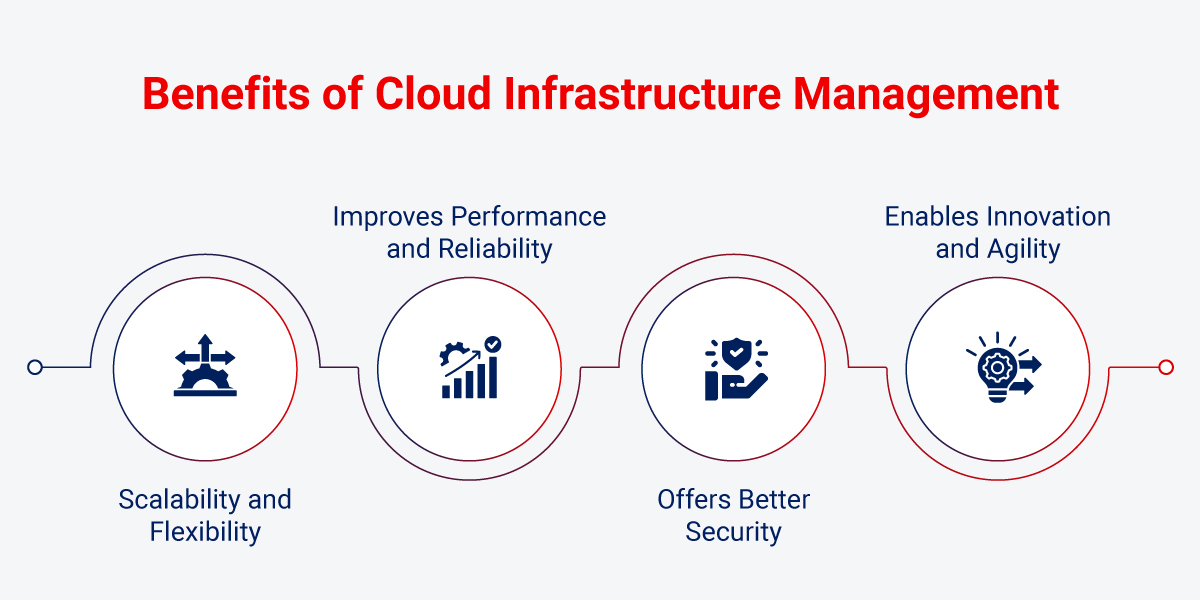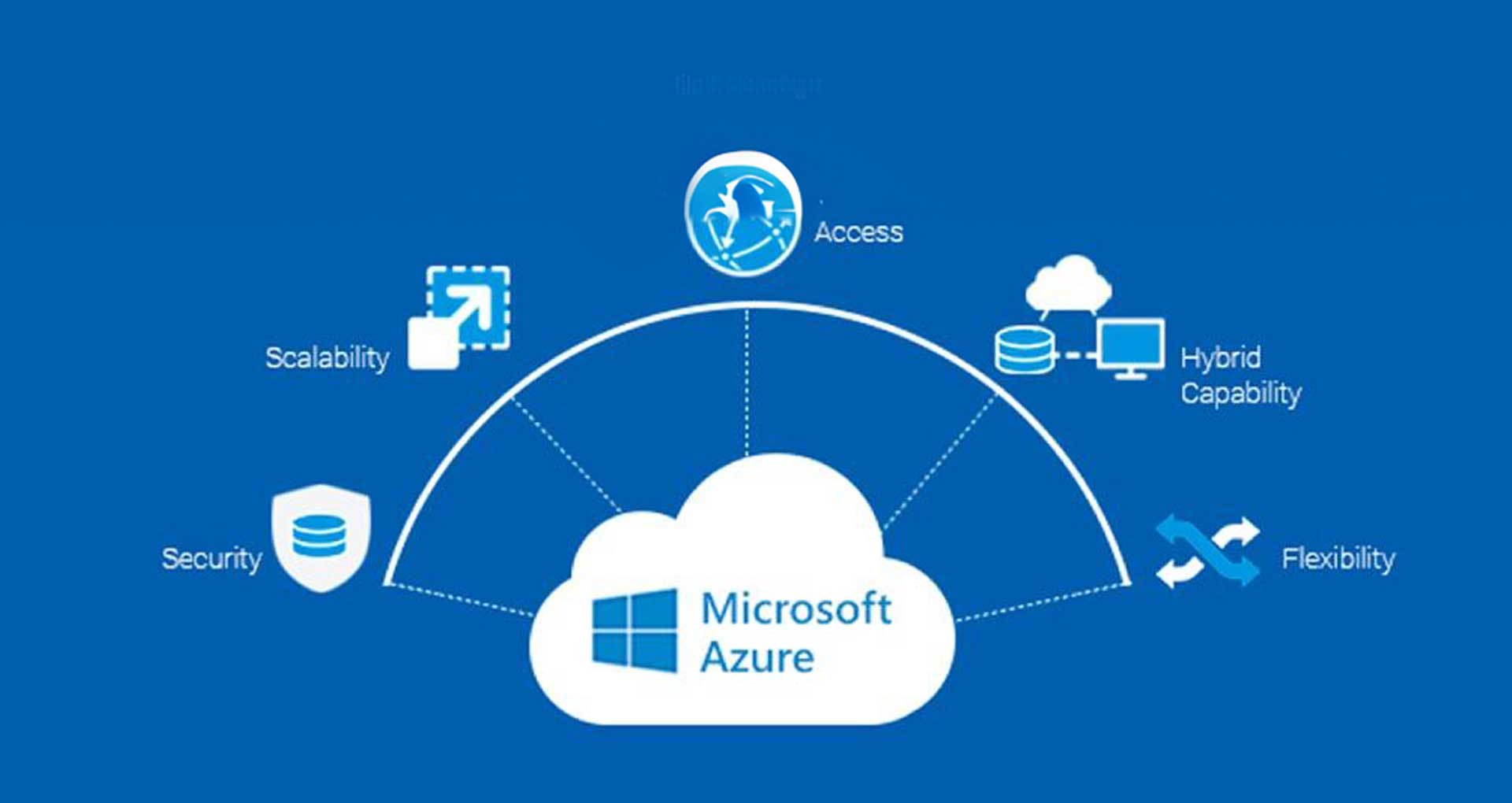Reliable and efficient cloud services have certainly become a valuable foundation for digital transformation. The innovation that lies in the flexibility and scalability of the cloud empowers businesses to seamlessly adopt digital business models. Here, cloud infrastructure is key to embracing the true benefits of the cloud, as adaptive cloud architecture enables the rapid development of applications, platforms, and solutions, dynamic resource allocation that simplifies management of cloud-powered solutions, and many more.
Cloud infrastructure management is essential for harnessing the full power of cloud computing. It helps optimize infrastructure, overcome challenges, and enables businesses to design, build, and migrate applications effectively. With mainstream strategies, companies can integrate and run applications smoothly while also visualizing the big picture to ensure efficient operations.
In this blog, we will explore more about how managing cloud infrastructure has become a crucial approach, its benefits, core components, best practices for implementation, tools, and much more.
An Overview of Core Cloud Infrastructure Components
The emergence of cloud computing has allowed businesses to access a wide range of services and resources without requiring substantial further investment. The need for and importance of cloud infrastructure and its efficient management are multiplying over time. From managing to storing and processing data, cloud infrastructure and its combined components are core to maintaining smooth business operations. These solutions provide an extended level of security and protection compared to on-premises systems. Here is a quick list of cloud infrastructure components:
- Hardware: It includes physical devices like servers, storage devices, and network infrastructure components like routers, switches, and firewalls used for supporting the infrastructure. These enable effective communication and make up the underlying infrastructure of the cloud.
- Software: It includes various types of software such as operating systems, middleware, virtualization software, programs, and cloud management tools. These provide the necessary capabilities to utilize cloud infrastructure to enable virtualization, management, automation, and orchestration of cloud resources.
- Virtualization: In managing cloud infrastructure, virtualization refers to the process of creating virtual versions of physical hardware resources, which includes servers, storage devices, routing, networks, and more. There are various types of virtualizations that are capable of optimizing resource utilization.
- Storage: A distributed storage system in cloud infrastructure enables a strong and secure way for managing, storing, and retrieving data across virtual and physical systems. It offers a scalable, secure, and flexible path for businesses to rely on cloud-based storage instead of on-premises hardware.
- Network: These include the physical and virtual networks that enable seamless data transfer between hardware components, software solutions, and other systems through internal and external network connections.
Benefits of Managing Cloud Infrastructure
Efficiently managing cloud infrastructure is integral to leveraging cloud computing services. Here are the key benefits of effective cloud infrastructure management for CTOs and engineering teams:

Scalability and Flexibility
Cloud infrastructure management enables your business to quickly increase or decrease cloud environment resources to meet your business needs. Through provisioning and deploying Infrastructure as Code (IaC) using tools like Terraform and AWS CloudFormation, you can leverage automation to streamline infrastructure configuration and management. Meanwhile, containerization platforms such as Docker and Kubernetes are key technologies that not only facilitate the deployment and scaling of applications but also offer flexibility across the cloud environment. Factors like continuous management and monitoring through techniques like predictive auto-scaling and multi-zone load balancing further help achieve scalability by maintaining optimal operations.
Improves Performance and Reliability
In the process of managing cloud infrastructure, several processes and approaches are generally adopted to make significant enhancements in the performance and reliability of the cloud environment and all applications and solutions. Scaling up and down for resource allocation and usage in real-time helps avoid slowdowns, while load balancing distributes traffic across multiple servers to prevent bottlenecks and ensure consistent performance. Another crucial point is continuous monitoring and tracking of system performance, allowing for immediate issue resolution without fail to ensure that problems do not escalate. Overall, effective infrastructure management provides a better user experience by increasing fault tolerance and reducing the impact of future failures.
Offers Better Security
The demand for a higher degree of cloud security can be much easier to achieve with cloud infrastructure management services. Adopting a multi-layered approach helps businesses enhance their level of security and protection. This includes basic identity and access management and the utilization of cloud management tools for data encryption protocols, especially for data at rest as well as in transit, serving as a protective layer for critical information and safeguarding against potential breaches. Also, to bolster security, cloud management employs firewalls and intrusion detection and prevention systems (IDPS) to monitor network traffic and capture suspicious activities.
Enables Innovation and Agility
Efficient management of cloud infrastructure can foster innovation by offering a scalable and flexible cloud environment that supports the building and deployment of new solutions. The full-stack cloud managed services such as serverless computing and container orchestration empower development teams to build, deploy, and manage applications with speed and efficiency. With proper cloud infrastructure management, businesses can release new features more frequently, maintaining product quality and responsiveness.
Major Types of Cloud Infrastructure
There are three major categories of cloud infrastructures: private, public, and hybrid. In this section, we will quickly explore each of these types of cloud infrastructure.
Private Cloud: It is dedicated to a single business in which control is totally in the hands of a single organization within its servers. They have the authority to manage the cloud environment and its resources solely.
Public Cloud: Here, third-party service providers or vendors come into existence, such as AWS, Azure, and many others, allowing businesses and individuals across the globe to leverage services through a pay-as-you-go model. Thus, it can be accessible for any type of business or project.
Hybrid Cloud: It is a pure combination of the above two mentioned cloud environment types, private and public.
Learn more about different cloud environments in our blog on Multi-cloud vs Hybrid Cloud.
Best Practices for Effective Cloud Infrastructure Management
To ensure outcome-driven management of cloud infrastructure, it is essential to focus on evolving industry best practices and trends. Here, we have listed the top best practices:
- Explore Automation at Your Pace: Integrating AI in cloud computing and infrastructure management automates repetitive tasks such as monitoring, scaling up and down, provisioning, and many others. It improves productivity, enhances efficiency, and reduces human errors and associated risk factors.
- Implement Robust Security Measures: Cloud environments often store confidential business data and personal information. Maintaining a strong security posture by using encryption, firewalls, access management, conducting regular security audits, and other security measures is important to stay vigilant and ensure the protection of the cloud environment.
- Utilize Cost Management Tools: From optimizing cloud costs to adopting cost management tools, these solutions assist businesses in saving on spending beyond the limits and aligning infrastructure costs with the defined budget.
- Regular Monitoring and Maintenance: In the process of Infrastructure management of the cloud, continuous monitoring of various aspects such as network, storage, hardware components, CPU, and many others allows businesses to identify potential security threats, ensure optimal system performance, and help track system performance.
Cloud Infrastructure Management Tools
Tools for cloud infrastructure management help engineering teams manage and optimize cloud resources to streamline the day-to-day operations of the cloud environment. Let’s discuss the most important ones to employ.
- Monitoring and Performance Management: Tools like AWS CloudWatch, New Relic, and others that fall in this category primarily focus on tracking performance and availability of cloud resources. They feature-rich tools that provide insights into operations, usage patterns, and potential bottlenecks.
- Cost Optimization and Management: Tools AWS Cost Explorer, Azure Cost Management, Flexera, and others are known for analyzing and getting information on the spending of business for managing cloud environment. Also, assist businesses in budgeting and forecasting for future cloud expense and management.
- Automation and Orchestration: With automation tools, businesses can streamline the development and deployment of cloud resources. Tools like Terraform, Ansible, and others allow teams to define IaC and automate repetitive tasks
- Backup and Disaster Recovery: These tools are developed to provide data protection by facilitating daily backups and offering recovery options. Veeam, Azure Disaster Recovery, AWS Backup, and other such tools allow businesses to recover data quickly and improve resilience.
Common Challenges in Cloud Infrastructure Management and Solutions to Overcome Them
Managing cloud infrastructure presents several significant technical, operational, and strategic challenges. Below are some of the common challenges, along with practical solutions.
Limited Visibility
Businesses often seem to struggle to get end-to-end visibility into their cloud resources, including software, hardware, and others. This lack of insight drives negative results such as inefficient resource allocation, unnoticed security vulnerabilities, and difficulties in tracking usage and costs.
Solution: To overcome this challenge, businesses should implement comprehensive cloud monitoring tools such as CloudWatch and Datadog that provide end-to-end visibility on various factors of the cloud environment. These tools provide real-time analytics on resource usage, performance metrics, and security status. Deploying centralized logging and monitoring solutions apart from regular audits of cloud resources can also help maintain an accurate inventory, maintain streamlined operation flow, and ensure that all assets are accounted for and managed effectively.
Cost Management and Optimization
Businesses frequently struggle with unexpected spikes in bills that can significantly impact the budget. This may happen due to the business overlooking the rise in on-demand pricing or not using cost-saving techniques and tools. The further presence of unused or underutilized resources, too, results in revenue leakages. Additionally, the complex pricing models make it challenging for businesses to cloud spending accurately.
Solution: Implementing automated cost monitoring can serve as an early warning mechanism to help teams identify unusual spending patterns before they escalate into major costs. Further, regularly right-sizing resources ensures that applications run on appropriately sized infrastructure.
Siloed Data & Services
In a multi-cloud environment, data and services can often become isolated within different departments or even result in inconsistent API management. This directly leads to inefficiencies and difficulties in accessing critical information, which impacts collaboration and slows down decision-making processes.
Solution: Adopting a centralized data management strategy can help overcome the challenge. This approach involves integrating data lakes for easier access and collaboration across teams. , deploying API gateways to enable easier access and collaboration across teams. Deploying API gateways to connect disparate systems can also facilitate data sharing and improve overall operational efficiency.
Compliance and Governance
Complying with stringent industry regulations such as HIPAA, GDPR, and data governance standards is among the major complex tasks in cloud environments. The need for continuous compliance monitoring and the maintenance of a comprehensive audit trail further adds to these challenges. Businesses may find it challenging to ensure that their cloud practices align with legal requirements, leading to potential penalties.
Solution: Establishing a clear governance framework is crucial. This framework should include regular compliance audits, implementation of automated compliance tools, continuous monitoring of cloud activities, and staff training on compliance requirements. This will help cultivate a culture of accountability regarding data management practices.
Complexity and Distributed Systems
Every cloud provider has its own set of tools, interfaces, and APIs that make it a challenge for any business to track and monitor each component thoroughly. It becomes quite challenging for a business to maintain consistency and proper communication between all the components.
Solution: Businesses should implement a unified management platform to address the complexity of distributed systems. Such platforms allow for centralized operations management control over various cloud services, reducing the need for multiple tools and minimizing the risk of errors. Additionally, adopting IaC practices for automation for routine tasks can alleviate the burden on IT staff, allowing them to focus on strategic initiatives rather than day-to-day management issues.
Partner with Rishabh Software to Improve Your Cloud Infrastructure Management Strategy
As a prominent cloud computing development service provider, we offer practice-proven expertise across the entire cloud lifecycle to accelerate business transformation and get the most out of high-performance cloud environments.
Our comprehensive services encompass the design, migration, and deployment of cloud infrastructures, along with seamless integration of private and public cloud environments. Through continuous cloud infrastructure management, we excel in monitoring, administering, analyzing, and proactively tuning the performance of cloud infrastructure components while ensuring optimal network maintenance and cost optimization.
As Select Tier Services Partners for AWS and Microsoft Azure, we help your business get a head start for speedy delivery of cloud implementations with app consultation, development, modernization, migration, and infrastructure management for performance and cost-efficiency. From initial cloud migration to cloud modernization and from cloud readiness assessments to crafting future cloud strategies, our team brings hands-on experience across all cloud-related areas. By implementing the latest cloud tools and technologies, we empower businesses to efficiently manage complex processes with robust security measures and AI integration, driving automation and operational excellence.
Frequently Asked Questions
Q: What is cloud infrastructure management?
A: It is the process of overseeing and optimizing cloud resources, including computing, storage, and networking. It ensures that these resources are efficiently utilized, secure, and scalable to meet business needs.
Q: Future trends in cloud infrastructure management
A: Future trends include increased automation through AI and machine learning, which will enhance resource management and efficiency. Additionally, the rise of multi-cloud and hybrid cloud strategies will demand tools that provide seamless integration and management across various platforms.
Q: How the cloud infrastructure works
A: Cloud infrastructure operates through a network of remote servers hosted on the Internet to store, manage, and process data. Users access these resources via the cloud service provider, which handles the underlying hardware and software management.
Q: What are the three major pillars of cloud infrastructure?
A: The three major pillars of cloud infrastructure are computing, storage, and networking. These elements work together to provide the resources necessary for hosting applications and managing data in the cloud.
Q: Role of cloud infrastructure in cloud computing
A: Cloud infrastructure serves as the foundation for cloud computing, enabling on-demand access to computing resources. It supports the delivery of services and applications, facilitating scalability, flexibility, and cost efficiency for businesses.











 30 Min
30 Min


